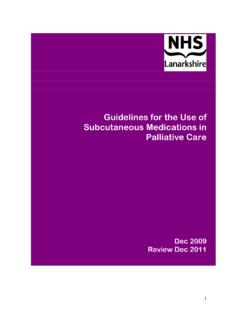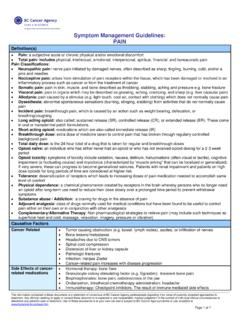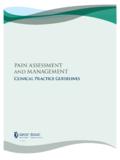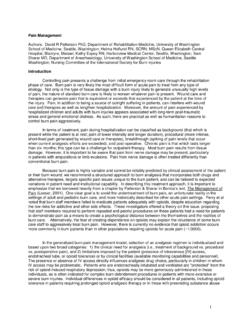Transcription of Daily Pain Assessment Chart - NHS Lanarkshire
1 Daily pain Assessment Chart Addressograph CHI No .. Hospital No .. Ward .. Name .. Consultant .. q Hairmyres q Monklands q Wishaw Once Daily - ask your patient: Overall, how would you rate your level of pain during the last 24 hours - none, mild, moderate, severe or very severe? Date Time Signature 4 very severe 4. 3 severe 3. 2 moderate 2. 1 mild 1. 0 none 0. q drowsiness q drowsiness q drowsiness q drowsiness q drowsiness q drowsiness q drowsiness q drowsiness q drowsiness q drowsiness q drowsiness q drowsiness q drowsiness q drowsiness q confusion q confusion q confusion q confusion q confusion q confusion q confusion q confusion q confusion q confusion q confusion q confusion q confusion q confusion Please tick q hallucinations q hallucinations q hallucinations q hallucinations q hallucinations q hallucinations q hallucinations q hallucinations q hallucinations q hallucinations q hallucinations q hallucinations q hallucinations q hallucinations appropriate box if signs of opioid q jerking q jerking q jerking q jerking q jerking q jerking q jerking q jerking q jerking q jerking q jerking q jerking q jerking q jerking toxicity are present.
2 V every cancer patient should be asked about their pain on v if pain >2, an urgent reassessment of pain and review of admission and should have a Daily score recorded unless on analgesia is needed (see overleaf for guidelines). post-op protocol v if pain >3 for 24 hours, or side effects of medication are v when commencing the Chart , please enter all dates along apparent, consider contacting the Specialist Palliative Care Team the top row v reduction of pain to a level acceptable to the patient should usually be achieved within 48 hours pain Management Guideline Step 1: Mild pain pain should be fully assessed before treatment with Paracetamol and/or NSAID +/- Adjuvant analgesics is started (see pain Assessment Guide). 1g, 4 times/day (if not contra-indicated) Continue to ask the patient about their pain regularly. Step 2: Mild to Moderate pain Discuss and resolve any concerns about Opioid + Paracetamol and/or NSAID +/- Adjuvant taking opioids addiction, tolerance, codeine 30-60mg, 4 times/day (if not contraindicated).
3 Opioids only for advanced disease, etc. or dihydrocodeine 30-60mg, 4 times/day Best given as a combined preparation Prescribe a regular laxative when opioids co-codamol 30/500, 2 tablets, 4 times/day are being taken regularly (see step 3). Step 3: Moderate to Severe pain Opioid + Paracetamol and/or NSAID +/- Adjuvant (if not contraindicated). Stop step 2 opioid Regular laxative Prophylactic antiemetic (full Daily dose of codeine (240mgs) is approx equivalent to 24mgs oral morphine/day) Movicol Prescribed as required, for 7-10 days Whenever possible titration should be with Senna + Docusate Co-danthramer metoclopramide 10mg 3 times/day normal release oral morphine or (if prognosis limited). If starting with normal release If starting with controlled release haloperidol nocte oral morphine, ( oramorph) oral morphine, Seek advice: 5-10mg, 4 hourly and as required ( MST Continus) v Severe pain v Dose of opioid increasing rapidly for breakthough pain .
4 10-15mg 12 hourly and v Movement related pain v pain not responding to treatment (A dose may be enough in the normal release morphine 5mg as elderly or those with renal impairment) required for breakthrough pain . Breakthrough pain Dose Titration in Step 3. v Prescribe normal release morphine at 1/6th of v Consider increasing regular oral opioid dose regular 24hour dose. each day in steps of about 1/3 (or according to v Subcutaneous morphine should be prescribed breakthrough doses used in previous 24 hours) or at half the oral breakthrough dose if oral route is until pain is controlled or side effects develop. problematic v Ranges of doses should be avoided Subcutaneous (SC) Analgesia v Please always assess response to breakthrough When converting to a s/c opioid: analgesia 30-60 mins after administration, and v Calculate the total 24hour dose of oral morphine record in nursing notes and divide by 2.
5 V If alternative opioids being used seek advice. v This is the 24hour s/c dose which is usually given in a syringe pump Adjuvant Therapies v Prescribe 1/6th of the 24hour dose s/c as v ANTICONVULSANT - required for breakthrough pain . nerve pain , Gabapentin100-300mg Daily initially and titrate gradually to 3 times Daily regime. Opioid Toxicity (seek advice). v AMITRIPTYLINE - v Increasing drowsiness nerve pain 10-25mg nocte and titrate v Vivid dreams/hallucinations (can cause sedation, confusion, dry mouth). v Muscle twitching/myoclonus/jerking v STEROIDS - dexamethasone raised intracranial pressure v Abnormal skin sensitivity to touch (8-16mg/day), nerve pain (8-16mg/day), liver Reduce opioid dose by 1/3 and ensure pain (4-6mg/day). Give before mid-afternoon, patient adequately hydrated, using SC/IV. reduce to lowest effective dose (monitor blood fluids if necessary glucose levels).
6 Consider adjuvant therapies and/or v TENS, NERVE BLOCK, RADIOTHERAPY, alternative opioids BISPHOSPHONATES. Adapted from SIGN Guideline, Control of pain in Patients with Cancer'














